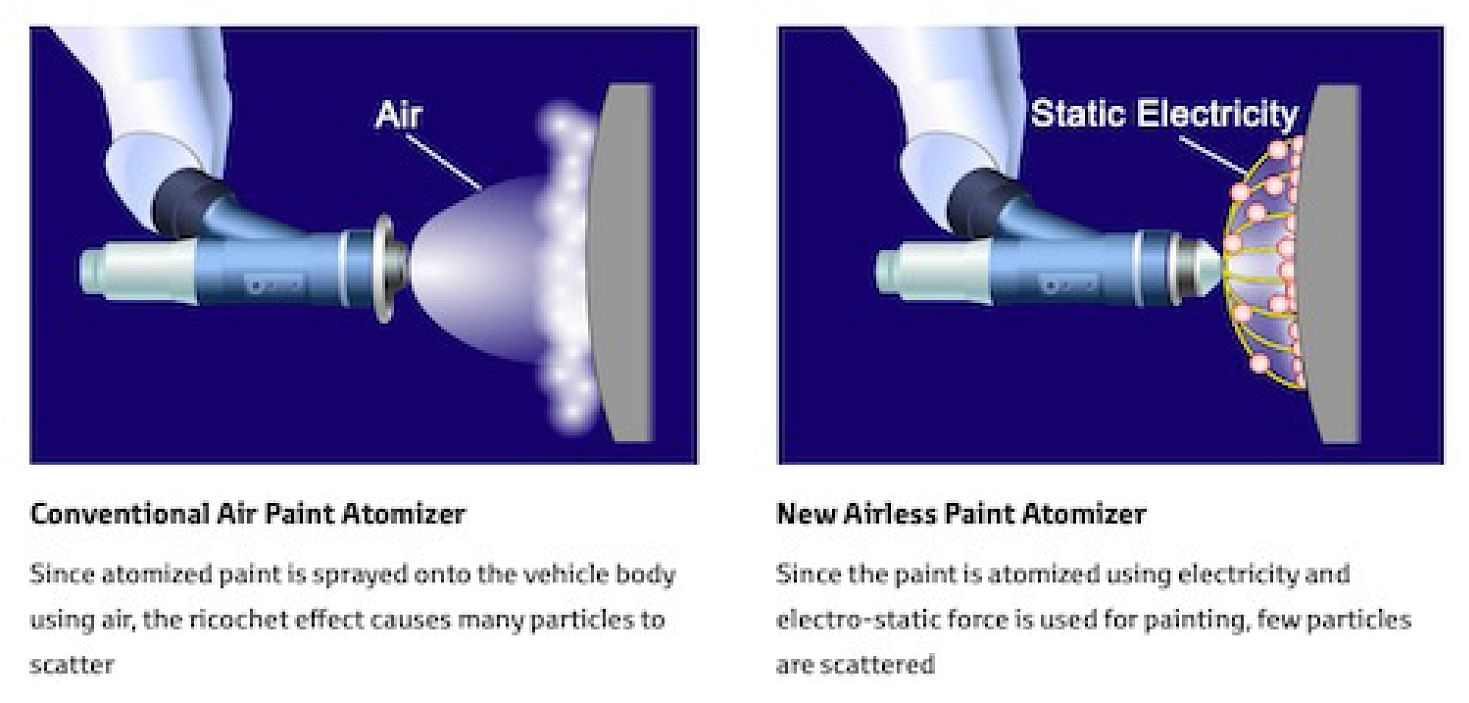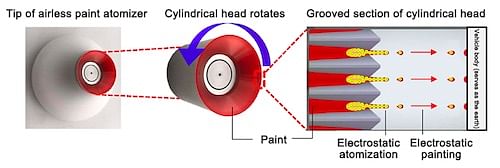Toyota develops new paint atomiser with over 95% coating efficiency
World's first technology that paints vehicle bodies with atomised paint particles using static electricity; achieves over 95% coating efficiency compared to 60-70% in conventional processes.
Toyota Motor Corporation has developed a new type of paint atomiser (airless paint atomiser) that uses static electricity instead of air, to replace the conventional air paint atomisers used in the vehicle body painting process. The newly developed airless painter, the first of its kind in the world, achieves over 95 percent coating efficiency (the amount of paint sprayed versus the amount that actually adheres onto the vehicle body), the highest in the world, from conventional efficiency of approximately 60 to 70 percent.
By deploying the airless paint atomiser in Toyota Group's painting process, it is expected that the Group can reduce its CO2 emissions by about 7 percent. In addition, the collection device situated at the bottom of the paint booth (the area where paint is sprayed) can be made more compact. Therefore, it is able to make painting production lines more compact for the future.



Toyota is advancing initiatives to achieve its Plant Zero CO2 Emissions Challenge, one of the targets included in the Toyota Environmental Challenge 2050 announced in 2015. As part of this effort, it developed the airless paint atomizer and deployed it at both Takaoka and Tsutsumi Plants. Gradual deployment at other plants is planned as well as consideration of deployment among other Toyota Group companies and licensing the technology to other companies.
Features of airless paint atomiser
Conventional air paint atomiser sprayed paint primarily using aerodynamic force, then paint the vehicle body with the atomized particles using an air paint atomiser. For this reason, paint particles are scattered by the air ricocheting off the vehicle body, resulting in a coating efficiency of approximately 60 to 70 percent. By comparison, the new airless paint atomiser uses electricity to sprayed the paint (electrostatic atomization), and the statically charged particles coat in such a way that they gravitate toward the vehicle body (electrostatic painting). Electrostatic atomisation and electrostatic painting technologies greatly reduce the number of atomised particles that scatter, thereby achieving a higher coating efficiency.
New technologies that achieve high coating efficiency
- The tip of the airless paint atomiser features a rotating cylindrical head that optimises the amount of paint sprayed
Electrostatic atomisation technology is used in beauty treatment devices and other instruments that spray fine amounts of liquid; here, it is applied to vehicle body painting. Specifically, the tip of the paint sprayer is cylindrical. Approximately 600 special grooves are inserted into the tip, which is rotated to create a centrifugal force, inducing the paint to flow into the grooves and atomise through static electricity..
- Highly accurate current control that makes close-range painting possible
The unevenness of the vehicle body causes the distance between the cylindrical head and the vehicle body to fluctuate, making the electrical current unstable. However, the airless paint atomiser constantly monitors the variations in current and automatically controls the voltage, maintaining a distance of approximately 10 centimetres between the cylindrical head and the vehicle body. Hence, electrostatic atomisation and electrostatic painting under a fixed current is rendered possible, in turn preventing variation in the size of the paint particles -- the result is high-quality painting.
RELATED ARTICLES
Gestamp targets Japanese automakers with new safety innovations
At AEA 2025 held in Yokohama, the company showcased its latest technological innovations and developments designed to re...
Five Toyota Group companies to push the AI and software envelope
The Toyota Software Academy, set up by Aisin, Denso, Toyota Tsusho, Toyota Motor Corporation, and Woven by Toyota, ims t...
BYD outsells Tesla for the first time in Europe in April
With retail sales of 7,231 BEVs in Europe in April, BYD sold 66 more all-electric cars than Tesla, which registered 7,16...





 By Autocar Professional Bureau
By Autocar Professional Bureau
 12 Mar 2020
12 Mar 2020
 8606 Views
8606 Views









